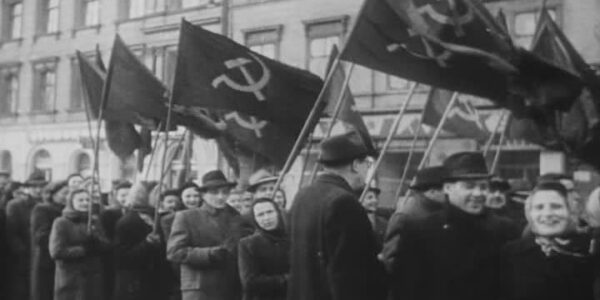By Patrick van Schie
On August 1, 1975, leaders of 35 states – from Europe, the United States, and Canada – gathered in the modernist new Finlandia Hall in Helsinki. There, they signed a document of roughly 22,000 words: the Helsinki Final Act. This Final Act was intended to establish new, improved relations between East and West, between the communist bloc led by the Soviet Union and the free West. Neutral states were also represented, including Switzerland and the Vatican – the latter participating in a summit for the first time since the Congress of Vienna (1815). But what was the true significance of the Final Act? Did it really mark the beginning of a new relationship?
From Molotov Proposal to Basket Discussions
The idea for a conference to formalize postwar relations was first proposed in 1954 by Vyacheslav Molotov, the Soviet Union’s foreign minister. The West held back, as Molotov wanted a European-only conference – excluding the U.S. and Canada. In such a setting, the Soviet Union could dominate discussions and possibly undermine NATO. West Germany also declined, despite its desire to reunite with the Soviet-occupied German zone (the “GDR”), since Chancellor Konrad Adenauer believed Germany’s future lay in the West, as a free democracy.
The Soviets repeated Molotov’s proposal many times, but as long as they refused to include the U.S. and Canada, and demanded NATO’s dissolution as a precondition, the idea remained a non-starter.
In March 1969, change appeared on the horizon when the Soviet Union released a statement omitting its previous demands, now appearing open to talks with the U.S. and Canada. The shift was confirmed on April 3, 1969, by Soviet Ambassador Anatoly Dobrynin to U.S. National Security Advisor Henry Kissinger. In November 1972, discussions for the Conference on Security and Cooperation in Europe (CSCE) began at ambassador level and continued at ministerial level from July 1973.
On a Swiss ambassador’s suggestion, talks were divided into four so-called “baskets.” The 1st and 3rd baskets formed the core of the agreement. The 2nd basket concerned economic relations – not unimportant, as communist countries were eager for Western goods and hard currency, and West German Chancellor Willy Brandt hoped to bring change through trade (Wandel durch Handel). The 4th basket covered procedural follow-up.
It is often said that the 1st basket enshrined principles of non-interference and respect for existing borders, while the 3rd basket was about human rights. This isn’t entirely accurate. Although the Soviet Union and its satellite regimes prioritized the 1st basket, and the West favored the 3rd, the 1st basket also included principles like freedom of thought, conscience, and religion – concessions from the Soviets.
The communists valued the 1st basket most because it affirmed state sovereignty and non-interference in internal affairs, along with recognition of existing borders. Yet, this recognition didn’t go as far as the Soviets wanted: the agreement stated borders could be changed, but only peacefully and with mutual consent – not permanently frozen, as the Eastern Bloc had hoped.
The 3rd basket addressed the free exchange of people and ideas – including the right to family reunification, access to foreign media, and cultural exchanges. Naturally, a tension existed between the human rights commitments (found in both the 1st and 3rd baskets) and the principle of non-interference.
Statements by Leaders and Initial Reactions to the Final Act
At the Helsinki closing ceremony, U.S. President Gerald Ford expressed hope that the people of Eastern Europe would recognize America’s commitment to human rights and fundamental freedoms, and thus to the conference’s promises about freer movement of people, ideas, and information. In his memoirs, Ford claimed he looked Soviet leader Leonid Brezhnev in the eye while saying this, adding that all of Europe and North America were “sick and tired of seeing their hopes betrayed by empty words and broken promises.”
Brezhnev, by contrast, stated: “The most essential element in the final document is that no one should attempt to dictate to other peoples how they should manage their internal affairs based on any foreign policy considerations.” This did not bode well for implementation. Brezhnev wanted the agreement mainly to secure recognition of the status quo regarding borders.
Historian John Lewis Gaddis wrote in The Cold War:
“The Kremlin leader was almost capitalist in the importance he attached to this contractual obligation, which he believed would discourage future ‘Prague Springs’, reinforce the Brezhnev Doctrine, deflate dissidents inside the USSR, and ensure his reputation as a man of peace.”
Brezhnev also wanted the deal finalized before his upcoming U.S. visit. Despite resistance from within the Politburo, including top ideologue Mikhail Suslov, he pushed through. His Foreign Minister Andrei Gromyko argued, “We are masters in our own house” – in other words, they alone would decide what the words on freedom and human rights really meant. Brezhnev’s Helsinki speech reflected that mindset.
In the West, criticism came quickly. Franz Josef Strauss, leader of Germany’s CSU, called the Final Act a second Munich (referring to the 1938 deal that sacrificed Czechoslovakia to Hitler). Ronald Reagan and Margaret Thatcher (both not yet in power) also condemned the agreement, as did French philosopher Raymond Aron, calling it naive. U.S. media, from the conservative Wall Street Journal to the liberal New York Times, were skeptical. The NYT wrote:
“Never have so many struggled for so long over so little,” and urged the West to avoid any sense of euphoria.
Dissidents Inside and Outside the Soviet Bloc
Many dissidents from communist countries were just as harsh. Aleksandr Solzhenitsyn, the exiled author of The Gulag Archipelago, called the Final Act “the burial of Eastern Europe.”
Oswalds Akmentis, vice-chair of a Latvian-American organization, said before the summit:
“President Ford will sign his name on a miserable and un-American treaty – a treaty which buries the hopes of millions of Eastern European peoples in ever securing freedom and independence.”
Despite claims to the contrary, the U.S. did not recognize the Soviet annexation of the Baltic states by signing the Final Act.
Czech poet Egon Bondy called the agreement a “disgusting pact” and a “universal submission.” However, it’s important to note that the Final Act was not a treaty but rather a statement of intent.
There should be no illusions about the intentions of Soviet leaders and their communist counterparts. Yet, historian Adam Ulam noted in his book The Communists that the Final Act included not only what Brezhnev wanted but also “things that would greatly embarrass the Soviet Union.” Dissidents would later invoke the Helsinki Final Act as the legal and moral basis for their positions.
That the Soviet newspapers Pravda and Izvestia printed the entire text (as did Neues Deutschland in East Germany and Rudé Právo in Czechoslovakia) was a boon to dissidents. It gave them grounds to hold their governments accountable to their own promises.
In May 1976, the Moscow Helsinki Group was founded, including figures like Sakharov, Sharansky, and Orlov. In Poland, the KOR (Workers’ Defense Committee) emerged – an intellectual group that, alongside Solidarity, would spearhead mass resistance in 1980. And in January 1977, 242 Czechoslovak dissidents, including Václav Havel, released Charter 77, which soon gained around 1,900 signatures.
Even after 1975, Soviet and satellite regimes continued to persecute dissidents and suppress free expression and information. This was inherent to their system – without such repression, communist rule could not survive. But the Helsinki Final Act exposed the hypocrisy of these regimes. Their promises were shown to be hollow.
Freedom of expression, exchange of ideas, and human rights cannot exist under communism. Brezhnev himself called such things “poison” to be kept out. By contrast, U.S. Secretary of State George Shultz remarked in 1983 that the Soviet Union would be better off “stopping being afraid of its own people.”
Image: Photo taken at a later stage of Czech President Vaclav Havel’s political career, speaking at the opening ceremonies of the IMF/World Bank Annual Meetings in Prague. Annual Discussion. Source: http://www.imf.org/external/photo/allphoto.asp?g=12. Photo is in public domain as mentioned here: https://commons.wikimedia.org/wiki/File:Vaclav_Havel_IMF.jpg?uselang=nl#Licentie




Follow Us!